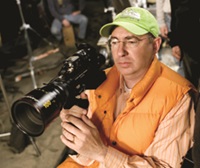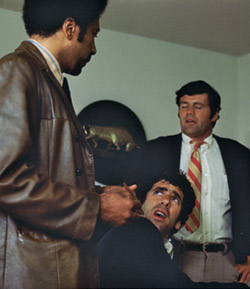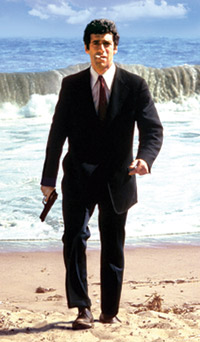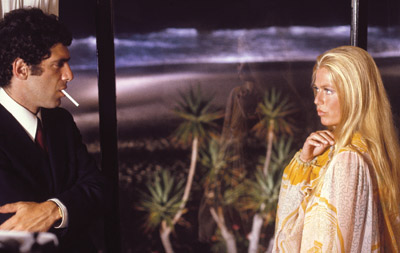BY ROB FELD
 INSPIRED: Barry Sonnenfeld admires
INSPIRED: Barry Sonnenfeld admires
how Robert Altman grabs the audience
by the shirt and says, "C'mon. Let's go
on an adventure."
"When I was attending film school, there were three movies I saw where I really sensed the director's joy in stylizing a film while keeping it real," Barry Sonnenfeld tells me as we drop into armchairs in his East Hampton screening room. "
Taxi Driver,
Mean Streets, and
The Long Goodbye."
We're here to watch The Long Goodbye and with a click of the remote, the MGM lion roars, the movie starts and Sonnenfeld leans back in his chair. "What Robert Altman did in The Long Goodbye had a big influence on me, showing that you don't have to shoot movies dryly. Stylizing and using the different elements of filmmaking make the experience interesting for an audience. It can take what is ultimately a fairly thin story and elevate it to something really entertaining, that, in a more standard presentation, would have been less successful."
Sonnenfeld remembers encountering The Long Goodbye a few years after its release in 1973, and again several years later when he was working with the Coen brothers. "There are lines from it we still repeat to each other," he says. Sonnenfeld began his career as a cinematographer, shooting films such as Blood Simple, Raising Arizona and Miller's Crossing for the Coens. Many of the films he shot exhibited the stylistic freedom he took from Altman's movie.
 All the angles are claustrophobic in Marlowe's
All the angles are claustrophobic in Marlowe's
(Elliott Gould) apartment, where he gets
roughed up by a couple of thugs."What I've tried to do as a cinematographer and director is what Altman does in this movie, which is to not just record events with the camera. He grabs the audience by the shirt and says, 'C'mon. Let's go on an adventure together.'"
Altman's take on Raymond Chandler's classic noir character, Philip Marlowe, is by turns a surreal, suspenseful and comic detective story that finds Marlowe (Elliott Gould) investigating the death of his best friend Terry Lennox (Jim Bouton), who, before supposedly taking his own life in a Mexico hotel room, murdered his wife back in Los Angeles.
The film opens with a tinny, big band rendition of "Hooray for Hollywood" on the radio as the camera floats through Marlowe's L.A. apartment, finding him crashed out on his bed, clothes and lights on. The music is Altman's nod to some of the campier aspects of his film. It is soon replaced by "The Long Goodbye," a haunting, atmospheric John Williams and Johnny Mercer composition that is the film's only score, which repeats itself in different variations throughout the picture.
"It's one of Williams' most inventive, free scores," says Sonnenfeld. "In this opening sequence, 'The Long Goodbye' also comes from Bouton's car radio as jazz, and as muzak when Marlowe goes to a grocery store. Later there's an Indian-styled version and a Mexican funeral dirge. I think it's a great conceit, a great effect. But more importantly I think it simplifies everything and unifies the entire film, which is basically about this dreary case Marlowe drifts through. He is so over his head until the end of the movie, when you're really surprised by what he does because you don't think he has it in him, and repeating the music supports that."
The muted blues and browns of Marlowe's apartment soon give way to a warmly glowing L.A. night with oddly blurred headlights and street-lamps. "Altman and [DP] Vilmos [Zsigmond] flashed the film, exposing it to the slightest additional bit of light in the lab before processing," Sonnenfeld explains. "It adds a bit of milkiness to the blacks, desaturates the colors and uncrisps everything. "They also did it to an extreme in McCabe and Mrs. Miller."
 MARLBORO MAN: Sonnenfeld admires the
MARLBORO MAN: Sonnenfeld admires the
"throwaway attitude" of Gould as Chandler's
anti-hero detective. In true film noir form, he
is summoned to the beach by a mysterious
woman to find her missing husband.Sonnenfeld perks up as the camera tracks inside Marlowe's apartment, spying him through the window as he returns home. "The camera rarely stops moving, which gives the slightest sense of energy to the scenes. It lets the camera be another character in the movie. As a cinematographer I've worked with directors who almost viewed the camera not as an enemy but just as a recording device. Altman doesn't do that; he uses the camera to tell or not tell the audience where to look."
Marlowe heads out to the grocery store to buy food for his finicky cat. When he returns, Lennox has blown in like a breath of stale air, claiming to be on the outs with a gangster (Mark Rydell) for whom he's been running money. After a midnight drive to drop Lennox in Mexico, Marlowe comes home to find two detectives waiting for him and soon gets the news that Lennox's wife has been murdered. As the detectives question Marlowe, Sonnenfeld points out the tight quarters of the location. "They probably did this scene three or four times. I imagine Altman saying, 'Give me a few different angles.' Today you would build Gould's apartment because it's just too small to shoot or light this real location. It's part of the reason why all the angles are claustrophobic here and they didn't come around to cover [other angles]—they're all shot from one direction, wherever they could get the camera in. I think it's because of the budget, but also the way movies were made back then."
Once Marlowe is taken to the station and thrown into an interrogation room, Altman is saddled with even tighter quarters, fighting to keep the film visually interesting and distinctive. "This is a hard scene to shoot," Sonnenfeld says, shaking his head. As the camera shoots through the two-way mirror, Marlowe's voice comes through the speakers thin and muffled. He and the detective step on each other's lines, lending the atmosphere that is distinctly Altman's.
"It has the same energy of people talking past each other like Altman's other films, yet of all of his movies I think it's the single most visually stylized, even more so than McCabe and Mrs. Miller," Sonnenfeld says as the camera moves into the room with Marlowe, shooting from below, zooming in and out. "You've got three walls and a piece of glass, but even here you can see the camera drifting just a little bit. Altman is getting coverage here, probably not sure which parts he'll use, but there's always this movement that makes it less flat and static. It brings you into the movie."
Screen adaptations of Chandler have always featured convoluted stories, and Altman obviously felt no need to simplify this one. When Marlowe is released and told that his pal Lennox is dead, in true noir form, he gets a message from a strange woman (Nina van Pallandt) whose author husband (Sterling Hayden) has gone missing. Marlowe is summoned to her beachfront property and Altman follows the operative as he wanders around the living room. When a still life on the wall catches Marlowe's attention, Sonnenfeld gets excited as a shot he's been waiting for approaches.
 THREE-WAY: Altman shot Gould and Nina van Pallandt talking in profile by the
THREE-WAY: Altman shot Gould and Nina van Pallandt talking in profile by the
window of her beachfront house while in between them in the distance, her
husband, Sterling Hayden, walks into the waves to commit suicide."Here it is," Sonnenfeld says as the camera zooms in to watch van Pallandt's 's reflection in the curved glass of the picture frame. "Altman shoots this film with a combination of a banal, straight-on style surrounded by these incredibly interesting, stylized shots. It's engaging and elevating."
As Marlowe tracks down and returns the inebriated writer to his wife, Sonnenfeld seems to get a kick out of Hayden's eccentric spirit and towering physical presence. "I like how Gould is always standing with his arms across his body, his body language saying, 'I'm uptight, I'm closed up.' While at the same time Hayden is this big, expansive personality who is always flinging around his arms, hands, and body."
Meanwhile back at the main plot, Marlowe gets a visit from the gangster and his thugs wanting to know where the money is that Lennox stole from him. As they hustle Marlowe upstairs to his apartment, Altman zooms in and holds on the semi-dressed, candle-dipping, yoga-practicing, hippie girls who live next door, as is the director's tendency when he encounters them throughout the film. Sonnenfeld comments on how much funnier the gag is when the girls are just seen doing their weird little thing in the background through Marlowe's window.
"See, through the window it allows us to find the joke, which I love," explains Sonnenfeld. "I don't think Altman quite decided if he wanted this scene to be funny or surreal. To me, the single biggest challenge for a director is consistency of tone. You create tone by a series of random answers to thousands of questions. Sometimes the way you answer the questions can be contradictory within the movie, and that's where tone comes in. Is this surreal or a comedy or a thriller? It's a hard line to walk."
The scene shifts back to the action and Sonnenfeld again anticipates a favorite moment and sits up for what he says is one of the best scenes in movie history. "This is a very surreal bit," he says. "The tension is profound, we don't know what's going to happen." What's going to happen is the gangster's mistress (Jo Ann Brody) gets scared waiting by herself in the car. After being solicitous to the girl and proclaiming his love, he smashes a Coke bottle across her face.
 STRANGE DAYS: The detective pays a visit to the hippie girls next door. Altman
STRANGE DAYS: The detective pays a visit to the hippie girls next door. Altman
zooms in on them from Marlowe's window throughout the film.

Gould's body language suggests someone uptight, while Hayden, always
flinging his arms around, is a big, expansive personality."What's great about the Coke bottle scene is that you can tell from the close-ups and tight profiles that something is going to happen. It starts out totally ordinary, with comments about how the Coke has only one sip left in it and what a loser Marlowe is. Then, what happens is so violent and shocking you don't see it coming at all. Yet it's believable. I also love that Altman doesn't put in music telegraphing the event. Pauline Kael talked about it being one of the most violent scenes in movie history just because it's so unexpected."
Marlowe follows the mobster's trail back to van Pallandt's Malibu home where Hayden is sleeping off a bender. Marlowe grills her about an affair he suspects her husband was having with Lennox's dead wife. It's nighttime three-shot with Marlowe and van Pallandt talking in profile. Between them, in the distance, Hayden is walking into the waves to commit suicide. "The camera pushes past them, slowly zooming in to Hayden fighting the waves," Sonnenfeld points out. "But Altman lets the audience find him, elbow their neighbor and say, 'Oh, watch this, this is going to be great.' There's no cutting to a close-up of Hayden in the water. He's in pretty deep and van Pallandt and Marlowe don't see it happening. The audience is, in effect, ahead of the actors and, they think, ahead of the filmmaker. The camera is in the best possible place and the staging sets up a triangle, telling two stories at once. It's fluid, smart and subtle, and lets the audience find the story in a totally controlled way."
After the thugs pick up Marlowe and bring him to their boss' house, Sonnenfeld notes the ethereal quality of the light outside the window "See how the out of focus lights in the background are ovals? It's because of the anamorphic format. Anamorphic lenses squeeze the image and make it really narrow, then the projector's lens spreads it out again. In film school you think, 'Someday I'm going to shoot anamorphic because it looks so cool.' It's a specific look."
Eventually, Marlowe puts the pieces of the puzzle together and heads south, realizing he was duped by Lennox, who isn't dead at all but did, in fact, kill his wife and is living pretty in Mexico with the now widowed van Pallandt. Sonnenfeld watches carefully as Marlowe approaches the camera from a distance along a road lined with trees on either side. "That says The Third Man to me," he says, referring to the final shot of Carol Reed's equally dark postwar noir. "What's lovely is that Marlowe loves Lennox enough that he's wanted to defend him even in his death, as Holly Martins did of Harry Lime. And now he realizes he's the dumb guy who's been totally scammed."
Marlowe's running line throughout the film, "It's okay with me," finally pays off when his moral outrage comes to a head. Now nothing is okay and he shoots his friend in cold blood. "I like how unremorseful Lennox is in this scene," Sonnenfeld says, as Marlowe strolls happily away and through the trees, playing a mini-harmonica and doing a jig.
Sonnenfeld leans back in his chair. "Watching Altman and Zsigmond shoot Los Angeles made me want to move there—which I still haven't done—become a film director and live at the beach. It's not a perfect movie, but the throwaway attitude of the lead character's acting, the stylized use of the camera and the soundtrack, the hip, sexy, posh look of the Malibu Colony, and L.A. in general, helped me get a sense of what kind of films I wanted to make. I learned that by stylizing a movie you can keep an audience more involved than by flying straight ahead."